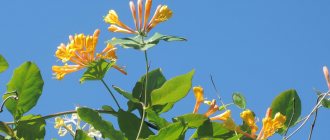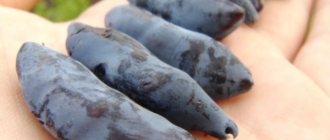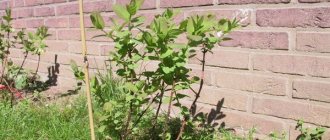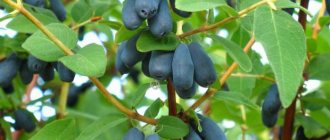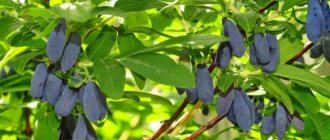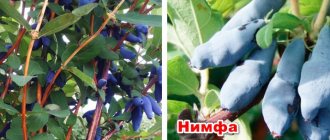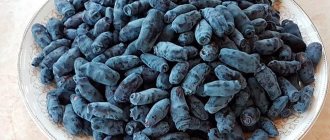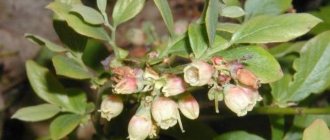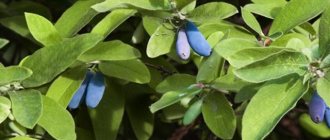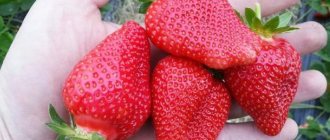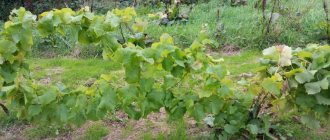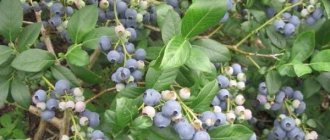Honeysuckle berries appear first in our gardens. When the trees are just blooming, the bushes of this plant already have fruits. The best varieties of honeysuckle not only have beneficial healing qualities, but also delight gardeners with an incredibly tasty harvest. Previously, its bushes were used as decorative decorations for gardens. But its amazing beneficial properties were soon discovered. And today, many species, for example: honeysuckle Blue Bird, Gourmand, Sorceress and many others, have become widely used in folk medicine.
The most common varieties
This plant literally burst into Russian gardens. Just twenty years ago, few people thought about growing it. In amateur gardening, the culture is widespread throughout our country, but most often it can be found in the Far East and the Urals, Eastern Siberia, and Altai. There is slightly less demand for it in the southern regions. The fact is that even the best varieties of honeysuckle cannot grow in too hot weather conditions.
The most unpretentious varieties are Viliga, Gzhelka, Zolushka. They were cultivated for growing in the cold Siberian regions. For example, the Viliga variety can withstand frost of fifty degrees. Gzhelka is considered a universal plant: it makes an excellent hedge, reaching a height of up to two meters, and it also produces magnificent sweet berries with a characteristic tartness. From each bush, subject to agrotechnical rules, you can get two and a half kilograms of harvest.
Advantages and disadvantages of the variety
Decorating your home with honeysuckle bushes
The main advantage of the Tatar honeysuckle variety of shrubs is its decorativeness and attractiveness, as well as:
- At the beginning of flowering, the plant pleases with the fragrant charm of pink color, and then the bush dresses up with carmine-red berries, very reminiscent of a scattering of bright shiny glossy beads. Thanks to these advantages, the plant will be a wonderful decoration of the entire landscape;
- The plant does not require care and, due to its undemanding nature, is rightly called “a shrub for the lazy.” Honeysuckle grows almost everywhere and in the spring pleases the eyes with its gorgeous, abundant flowering;
- In addition, a hedge of shrubs allows you to protect country lawns from uninvited visitors.
Disadvantages of the variety:
- A big disadvantage of honeysuckle is the possibility of damage by various pests and viral diseases. Therefore, for Tatar honeysuckle it is necessary to treat the plant with pesticides;
- To maintain the decorative appearance of a shrub, it is necessary to form and cut off overgrown branches in a timely manner;
- The berries of the fruit are not edible. This fact must be communicated to young children.
Tatar honeysuckle is an unpretentious shrub that tolerates summer drought and severe winter frosts. And in the spring it “dresses up” in a beautiful festive outfit, which makes even the most unattractive area become cozy and elegant.
Classification
Early varieties include Blue Bird, whose berries are not sour, Morena with very large fruits, Altair, etc. They are grown even in the Moscow region.
Medium-ripening varieties are considered to be Amphora, Dolphin, Berel honeysuckle (variety description, photos are presented below). Late-ripening species, whose berries ripen in the last days of June, are Kingfisher, Nymph, Ramenskaya.
One of the highest-yielding varieties of this plant, the Leningrad Giant, was bred in the Pavlovsk laboratory.
In general, it is difficult to say which variety of crop is the best. All varieties are good. Most of them delight their owners with tasty and healthy berries.
Honeysuckle Berel: variety description, photo
This species was developed by crossing the Blue Spindle, Blue Bird and Azure. Berel is a honeysuckle with tall, erect and slightly spreading bushes and an oval crown. The shoots of this plant are long and quite thick. They are brownish-green in color with anthocyanin coloration. The leaves are flat, medium-sized, round-oval. The berries produced by this plant are dark blue in color with a strong waxy coating. They are quite large, broadly fusiform. The weight of the fruit reaches one gram. The taste of the berries is sweet and sour with a characteristic bitterness. Berel is a honeysuckle that belongs to the average ripening period. The yield from each bush reaches three kilograms. Features of the variety are low shedding and high winter hardiness. Pollinators for Berel honeysuckle - Kamchatka species and its seedlings. The berries of this variety are used for canning - in compotes and natural juices, as well as for producing food coloring.
Popular types of decorative honeysuckle
Climbing plants that also have sweet fruits can serve as decoration in the garden. Shrub varieties with orange or red inedible fruits are also popular in landscape design. Among these or those species, several popular varieties stand out.
Characteristics of decorative honeysuckle options:
- Decorative options include the Blue Bird variety, which is characterized by bright greenery, miniature size, up to 1 m in height, and ease of care.
Obtaining fruits is possible only if there are several bushes of self-pollinating varieties of honeysuckle nearby. Therefore, the Blue Bird can be used, if necessary, as a decoration for the site; Growing honeysuckle is possible without producing fruits - The Morena variant is characterized by fruits whose length reaches 3 cm. The sweet and sour taste of the berries, rich aroma, bright flowers makes the plant optimal for decorating the garden.
The self-pollinating variety can be planted separately from other bushes; Morena bushes can be used as garden decoration or for producing berries. - The Blue Spindle variety is early ripening, produces large fruits, and has a compact size, which allows it to be planted in a small area.
Thin branches and graceful leaves make the bush an optimal element of landscape design; Oval blue berries effectively decorate the bushes - Tall bushes of the Tomichka variety have spreading branches and such plants are often planted in spacious areas.
Fruit setting is carried out with the help of the proximity of other varieties of honeysuckle; The fruits fall off quickly when ripe - The Violet variety is characterized by bushes whose height is up to 1.5 m. Rich green leaves, blue berries and flowers up to 2 cm in diameter make the plant beautiful.
Large berries weighing about 1.5 g, dark brown branches and ease of care distinguish this variety from many others. Fruit ripening occurs in early June; Large berries are juicy and have a rich color - The curly version of Honeysuckle is common and easy to care for.
Liana-like branches with lush flowers allow you to decorate the garden. The plant has red, inedible fruits, and the root system is resistant to cold weather; Honeysuckle is convenient for decorating gazebos
All decorative options have a graceful bush shape or are characterized by beautiful weaving around supports. Lanceolate green leaves contrast with the bright fruits and make honeysuckle a good addition to the garden.
Soil requirements
Berel is a self-sterile honeysuckle. Therefore, in order to get a good harvest, it needs to be planted in one area next to another variety or with its seedlings. Only in this case will insects ensure cross-pollination of the bushes. In some regions, Berel honeysuckle is considered a very important honey plant. It is planted from spring to autumn, with the exception of May and June. During these months, Berel honeysuckle is in the most active stage of shoot growth. Those who are going to plant a crop in the spring should know that this must be done even before the buds open. It should also be taken into account that Berel is a honeysuckle that awakens quite early.
Experts recommend planting this plant in the fall, starting from the last days of September until mid-October. To begin with, you should select the most comfortable place on the site, bring the soil composition to the required values, dig holes and prepare the seedlings for planting. Berel is a honeysuckle that is most suitable for light, wind-protected, low-lying, swampy areas. The plant can be planted near a fence or surrounded by bushes of other varieties. The soil must be fertile - loamy or sandy loam. Organic matter should be added to poor soil. In cases where the soil pH in a given area is shifted towards increased acidity, chalk or dolomite flour should be added to the soil.
Landing
Before placing the bushes in the ground, bushes of this variety of honeysuckle should be carefully inspected and broken roots and shoots should be removed. Planting is carried out in holes with a depth of up to forty centimeters. The distance between them should be from one to two meters. Well-rotted manure or humus, a little double superphosphate, wood ash and potassium sulfate should be added to the holes. Fertilizers should be thoroughly mixed with the top layer of soil. At the bottom of the holes, mounds should be formed and honeysuckle bushes should be installed on them. Then you need to straighten the roots and cover them with loose soil. You need to be careful that after planting the root collar is at a depth of three to five centimeters. Then, having compacted the soil around the seedlings, you should make sides around them and water the area with a bucket of water. After the moisture is absorbed, the soil around the bush is mulched with peat, humus or dry soil.
Berel, honeysuckle: growing features
The goal of any gardener growing this crop on his plot is a rich harvest. If all necessary conditions are met: regular watering, weeding, loosening the soil around the bushes, timely application of fertilizers, pruning and protection from pests, the plant will definitely delight you with its delicious berries. It should be borne in mind: the better the Berel honeysuckle is cared for, the more elegant its bushes look and the richer the harvest.
The growing process is facilitated by the fact that during the first three years after planting, the bushes only need to be hilled up high in the spring, of course, watered and loosened the soil, removing weeds. Young plants do not require pruning. Berel honeysuckle should be watered sparingly. Only in dry weather should moisture be supplied abundantly, since from a lack of water the berries begin to turn bitter and their quality is compromised. Pruning of honeysuckle in the spring is carried out more for sanitary purposes. In regions with mild weather and regular rainfall, the plant should be watered three or four times per season. The amount of water for each bush at a time should be ten liters.
Features of harvesting
Berries on honeysuckle bushes do not ripen at the same time. First, the fruits ripen at the very top of the plant, then in the depths of the crown, and finally, the berries growing in the lower part of the bush come in turn. At the same time, it is observed that the berries of many honeysuckle varieties quickly fall to the ground when ripe.
In falling varieties
To harvest such varieties of edible honeysuckle, gardeners use a simple secret: they spread fabric or plastic film around the bush, which protects the berries from contamination or the possibility of getting lost in the grass, and also makes the number of fallen fruits visible.
In resistant varieties
Some varieties of edible honeysuckle, such as Berel, have the ability to remain ripe for quite a long time. This allows you not to monitor the number of fallen fruits every day, but to collect ripe berries at once. At the same time, owners of garden and summer cottage plots also use the technique described above, spreading plastic film around the bushes. Only at the same time they shake the bush, after which all the berries fall off it together.
Trimming
The plant does not need it for the first two or three years after planting. And after that, if the shoots grow normally and the bush does not look too thick, you can take your time with it. In the best case, sanitary pruning of honeysuckle is carried out in the spring.
There are often cases when the process of thinning a bush is carried out only in the seventh or eighth year after planting. Although some agronomists recommend trimming the shoots on seedlings immediately after planting, shortening them to seven to eight centimeters. And after that, wait for the bush to increase its green mass. It is best to prune honeysuckle in the fall, after harvesting.
If the bush has become very thick, you can cut out several null branches growing directly from the ground. Dry, broken or too short branches must be removed. Fruits are formed only on strong annual shoots. Therefore, they should not be shortened. It is better to cut off the ends of shoots that have weak growth, but do not touch the middle and base.
Harvesting and storage
Honeysuckle berries are considered ripe when the fruits turn blue. But don't rush to take them off. It is recommended to do this after a week, so the berries will gain sweetness. Harvesting is carried out twice a day, as the fruits ripen unevenly.
A cloth or film is spread under the bush. This will help preserve fallen fruits. Honeysuckle is very tender and soft, so it should be placed in a basket in one layer or collected in a shallow container.
The shelf life of fresh Boreal Beauty is 2-3 days. It is better to consume the harvest immediately or freeze it, this way you can preserve the entire complex of useful substances.
Before freezing, the berries must be thoroughly washed and dried. Then place in a container or plastic bag and place in the freezer. This extends the shelf life of the berries to 1 year.
The fruits of the Kamchatka variety make delicious preserves, jams and compotes, and they also serve as an excellent filling for baked goods.
By planting honeysuckle in your garden, every gardener will be able to provide himself and his family with vitamin-rich berries for many years. Eating fruits will help strengthen the cardiovascular system, have anti-inflammatory and diuretic effects. The main thing to remember is that the main condition for growing edible Kamchatka honeysuckle Boreal Beauty and getting a rich harvest is to follow simple rules of agricultural technology.
How to propagate honeysuckle
There are three methods, each requiring certain knowledge and labor. Honeysuckle Berel propagates by seeds, cuttings and layering. Each of these methods has its pros and cons. For example, propagation by seeds is not difficult, but honeysuckle is a cross-pollinated plant, so the properties of the parents are not preserved in their offspring. Therefore, the new generation is inferior in quality. Because of this, this method is mainly used by breeders for experiments. The most effective methods of propagation are cuttings and layering.
Reproduction
Honeysuckle Berel can be propagated both by seed and vegetative methods. It is not difficult to grow seedlings from seeds, but the parental characteristics of such plants are often lost, so their quality will vary greatly for the worse. To preserve all the positive properties of Berel honeysuckle in full, vegetative propagation methods are used, such as cuttings, layering and dividing the bush.
Cuttings are an excellent way to propagate Berel honeysuckle. The highest percentage of rooting (up to 60%) is given by green cuttings taken from the bush at the very beginning of fruiting. For this purpose, annual shoots 15-40 cm long are used, and they are not cut off, but torn off from the mother branch “with a heel”. Berel honeysuckle cuttings prepared in this way are kept for 12-15 hours in a solution of a root formation stimulator, and then planted in special beds.
Beds for germinating cuttings must meet the following requirements:
- Good lighting in the morning, shade at lunchtime.
- Loose prepared soil from a mixture of sand, peat and turf soil.
Berel honeysuckle cuttings are planted obliquely, at an angle of 45 °, facing south. The soil should always be moderately moist. For the first time, it is better to cover the planting material with film from direct sunlight. The formation of its own root system in cuttings usually occurs within 3 weeks. In the first winter, young plants should be covered with spruce branches.
Another fairly simple way to propagate Berel honeysuckle is to divide the bush. Plants older than 10 years can be divided. In this case, the bush is dug out of the ground and several parts are separated from it, each of which contains at least 3 shoots with its own root system. The deprived parts are immediately planted in new places as independent seedlings.
Dividing a bush is an easy way to propagate Berel honeysuckle
Air layering from the Berel honeysuckle bush can be obtained by digging one of the side shoots. During the summer, a new root system will form in the internodes, and the cuttings will produce their own shoots. For the winter it is left with the mother shoot, and in the spring it is cut off and planted in a new place.
Fertilizers
During the first two years of life, honeysuckle does not need to be fed. Then only fertilizers are applied. It is better to give preference to organic matter. In late autumn, the bushes are fed with compost, ash and double superphosphate. In the spring, before the buds open, ammonium nitrate should be added to the soil every year at the rate of fifteen grams per square meter of land or with a urea solution (one tablespoon per bucket of water).
Rules of care
Honeysuckle Azure
Like any plant, honeysuckle needs feeding. This must be done in the spring; you can use organic and mineral fertilizers. You can fertilize with nitrogen until mid-June. In the fall, during digging, it is recommended to add wood ash.
From mid-summer, the plant begins to prepare for winter, and a slowdown in shoot growth is observed. During the same period, the leaves of the bush turn brown and fall off. Don't worry about this - it's a natural process.
Important! Water balance should be maintained. Watering should be done once a week. Recommended dose: for one adult bush – one bucket of water.
Proper pruning is an important element in honeysuckle care. It allows you to increase fruiting and berry size. Pruning recommendations:
- For better branching, it is recommended to tame the branches a little before planting in the ground;
- It is necessary to trim the branches of an adult shrub in the spring, before buds open, or in late autumn;
- Old and diseased shoots must be removed;
- If the branches grow close to the ground, so that the berries lie on it, then they must be pruned;
- To rejuvenate an old bush, it is recommended to cut off several large old branches annually. It is undesirable to completely trim the bush; it will be very stressful for it and can lead to death.
Pests and diseases
This type of honeysuckle is affected by pests such as aphids, mites, scale insects, fingerwings and other leaf-eating parasites. Among the diseases, fungal infections and phytoviruses are especially dangerous. Traditional methods and modern chemicals will help in the fight against them. Infusions of garlic, tobacco and pepper are considered the most effective. Among industrial chemicals, Aktara and Eleksar have proven themselves well in pest control.
High air humidity is dangerous for honeysuckle because it increases the risk of fungal infections, such as powdery mildew. A solution of copper sulfate or the drug “Topaz” will help to cope with them.
Reviews from gardeners
A wonderful berry crop, one might say, problem-free - this is exactly what our gardeners say about many varieties of this plant. Berel honeysuckle is no exception. Reviews about it indicate the great popularity of the variety in the central regions of the country. Many people like the fact that the shrub requires minimal care. This is especially true for those who go to the site only on weekends. In fact, today honeysuckle is the first berry to ripen in the garden. It produces a harvest even earlier than strawberries. The berries are incredibly tasty. Many domestic gardeners boast of compote made from them. Another advantage, according to gardeners, is that honeysuckle practically does not get sick and tolerates frost well. It can grow in one area for more than fifty years and still not lose its fruitfulness. The main thing is to choose the right neighboring varieties for good pollination. You need to buy at least two, otherwise there will be no berries. Berel stands out among other varieties in its taste and size of berries, so many choose this particular species for planting on their plots.
Harvest and storage
The berries mature at the end of the first ten days of June. The fruits ripen gradually, the main thing is to have time to pick them before they are fully ripe. After the berries turn blue, full ripeness occurs in 5–7 days. The harvest is harvested manually or by shaking the berries into an umbrella or cloth spread on the ground under the bush. To prevent the fruits from dripping, they must be removed from the bush without stalks. The harvested crop must be removed from the sun.
Tomichka can be stored in the refrigerator for up to 7 days. Thanks to the thick skin, the fruits can be transported. For transportation, the berries are placed in 2-3 kg containers made of natural materials. Honeysuckle makes excellent jam, compote, and jam. To increase shelf life and preserve nutrients, berries can be dried and frozen. These berries are stored for 3–4 years.
Tomichka is a bright representative of the honeysuckle family. It is tasty, healthy, and easy to care for. Despite some shortcomings, many gardeners fell in love with it. Try to breed Tomichka in your area. This will not only delight you with the wonderful taste of the berries, but will also decorate your garden with beautiful honeysuckle bushes.
